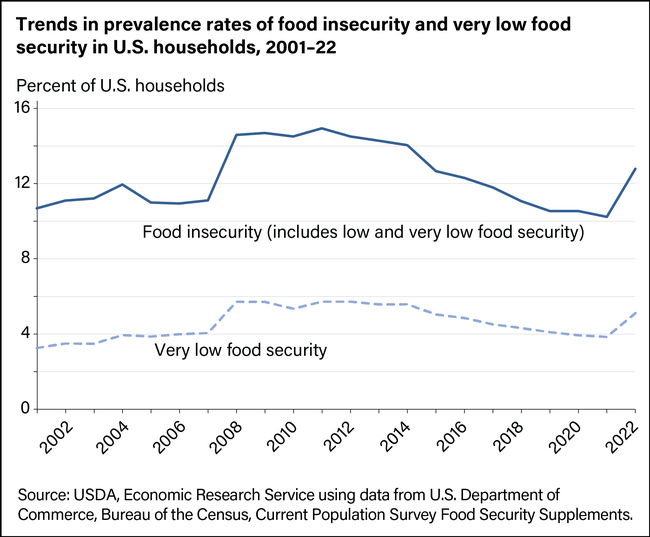In the last 12 months, have you ever:
- worried that your food would run out before you got money to buy more?
- been unable to afford balanced meals?
- cut the size of your meals or skipped meals because there wasn't enough money for food?
- lost weight because there wasn't enough money for food?
- relied on only a few kinds of low-cost foods to feed your children because there wasn't enough money for food?
- been unable to feed your children a balanced meal because you couldn't afford it?
If you answered yes to more than three of these, then you are likely among the 17 million American households (12.8% of us) who have experienced food insecurity. This is only a sample of the ten to 18 questions that the USDA uses to track and monitor household food security every year and to rate the level of food security based on participant households' responses from food secure to very low food security depending on the number of affirmative answers provided.
During the pandemic and in the years leading up to it, the rate of overall food insecurity stayed relatively stable. This seems surprising, that as millions of Americans lost their jobs and suffered from negative health consequences, food security remained flat. Only recently have we started to see the upward trend in food insecurity return.
In their 2023 report, the USDA Economic Research Service notes that food insecurity increased in 2022 across all subpopulations and was significantly higher than the 10.2% prevalence of food insecurity recorded in 2021.
Why didn't food insecurity increase during the COVID-19 pandemic? Why is it increasing now?
Perhaps, policy actions to support low-income households helped:
- In a Robert Wood Johnson Foundation Report (Aug 2022), researchers estimate that SNAP emergency allotments (a temporary increase in benefits in response to the COVID-19 pandemic among participating states which ended in the February 2023 issuance) “kept 4.2 million people out of poverty in the fourth quarter of 2021, reducing poverty by 9.6 percent in states with emergency allotments, relative to a scenario in which emergency allotments were eliminated. Child poverty was reduced by 14.0 percent in states with emergency allotments and was reduced most among Black, non Hispanic children, falling by 18.4 percent.”
- In another study (June 2022) researchers found that a 15% increase in SNAP benefits, enacted in January 2021, reduced instances of food insufficiency during the pandemic and also reduced food pantry visits (Bryant and Follett, 2022)
- In one nationally representative study (Dec 2023) of SNAP-participating households, discontinuation of SNAP emergency allotment benefits was significantly associated with increased food insufficiency.
- In a cross-sectional study (June 2023) of US respondents to the Census Bureau Household Pulse Survey, analyses showed that ending emergency allotments was associated with significantly higher overall food insufficiency and child food insufficiency.
SNAP Emergency Allotments were implemented in response to the pandemic. Following their expiration, the average SNAP participant was expected to receive about $90 less in benefits per month (Rosenbaum et al. 2023).
Perhaps this is telling us that, where there is a will to end food insecurity and hunger, there is a way.
See a local story about hunger in the Tribune Dec 7, 2023: https://www.sanluisobispo.com/news/local/article282183253.html
Author - Area Director for UCCE in San Luis Obispo, Santa Barbara, and Ventura Counties
